Scrum from a military pilot: The art of doing twice as much twice as fast
- Transfer
Jeff Sutherland (Jeff of Sutherland ), a military pilot (made more than 100 combat missions in Vietnam), coavtor Agile-manifesto and CEO Scrum.
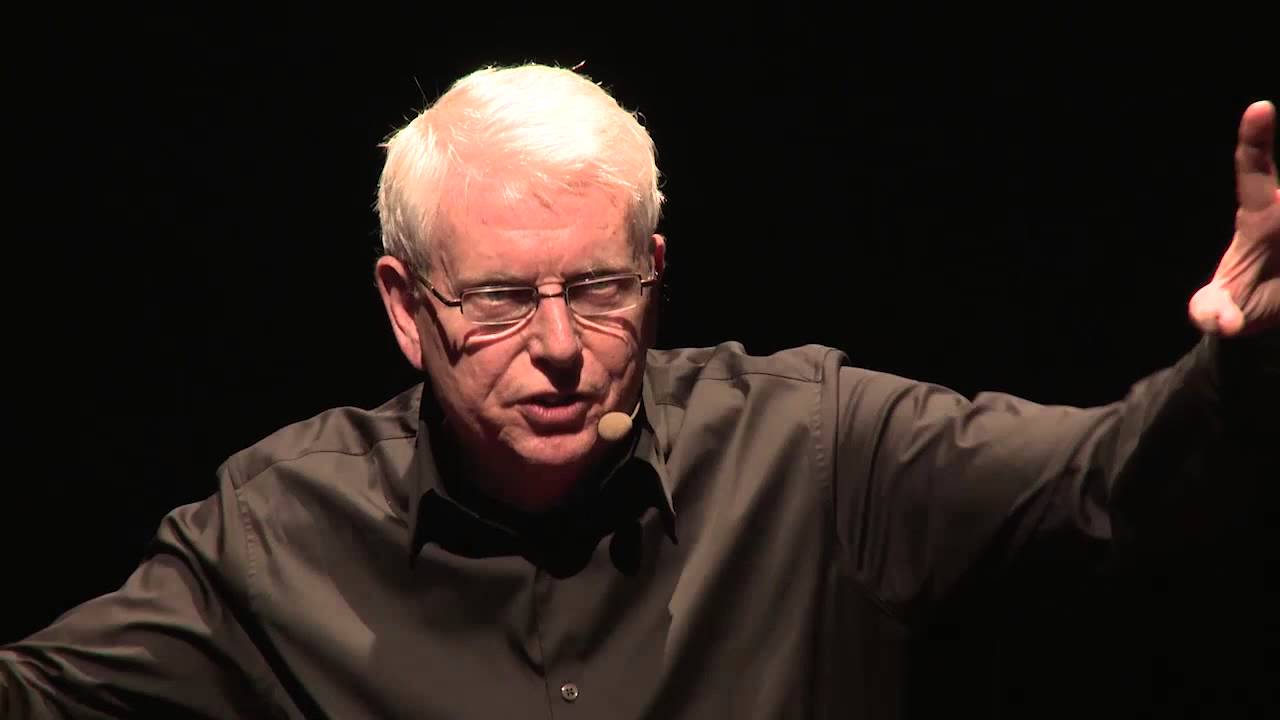
Hello!
Today I want to talk about life, freedom and the search for happiness - the Great American Dream, which often remains unfulfilled. As the poet Robert Burns said: “Even the most carefully constructed plans fail both in mice and humans,” which cannot but cause inconvenience and psychological discomfort, instead of the expected satisfaction.
I first encountered this problem as a cadet at the US Military Academy. During our training, we had to go through fire, water and copper pipes, and the year before graduation I was appointed an officer of the L2 company, which needed to solve the problem with drill training, as they had to participate in a military parade. The company was considered something like an outsider, because for a whole hundred years they could not do anything with the already established reputation of complete mediocrity and slackness. Decades went into futile attempts to teach them something and force them to train with great effort.
So I realized that I needed to do something completely new. And that’s what occurred to me: I won’t tell them what to do, but at night I will post color notes on the notice board in exactly the order in which their speech would look on the drill-ground, with precise indications of the shortcomings that they need to fix. For example, Charlie should stop, holding a weapon parallel to the floor, exactly in the middle of the march. The third platoon should be deployed synchronously, and its commander should pronounce commands distinctly, firmly and strictly at the indicated time.
To everyone's amazement, they became the best in the entire Cadet Corps in just three months. By that time, General MacArthur had died, who wished before his death that a group of cadets carry his coffin to the grave. The company L2 was chosen for this mission.
For those hopelessly lagging, escorting the deceased general to the grave is a big step forward. After graduating from the Academy, I joined the Air Force. Even at the Academy, I learned a lot from its leaders, I lived in a room with a fireplace, on which the inscription was carved: “Dwight D. Eisenhower lived here,” and, every time I read this inscription, I recalled his famous saying: “ Plans are nothing, planning is everything. ”
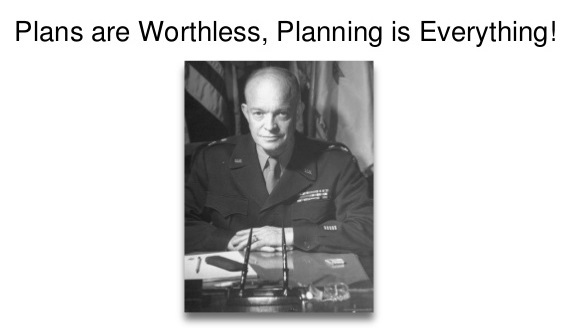
So when I became a combat pilot, I went into reconnaissance. We are constantly engaged in planning. But once one of my colleagues was shot down by a rocket over Vietnam. I knew that he really planned everything well. But he flew right over the target. And that was a deadly mistake.

From that day on, I began to include one prerequisite in my plan: to see my goal. And as soon as I was sent to North Vietnam, I mastered the evasion maneuver, because I knew that every second I was under fire. And only at the last moment, in one single second, I walked away from bullets, managing to take a photo.
And I stayed alive. Half of those with whom I flew did not return from their missions. When I again found myself in the USA, it was a complete surprise for me. I have been close to death so many times. Here I felt that I had found a new life. Every day was like a day of reward, a day of freedom. What was I to do with all this?
So I asked the Air Force to send me back to the aviation academy so I could teach there, or let me go back to school at Stanford. So I ended up at the Medical University of Colorado. I taught there for 11 years. There I worked in the field of building super-computer models of a human body cell, which would show how it develops, divides, and what provokes the formation of cancers, how to stop this process and how we can cure cancer.
And while I was there, a large banking company, under the control of which there are about 150 US banks, turned to us: “You are well aware that you have the most experience in developing the technologies that we use in our banks. You have knowledge, but no money. But we have money in banks. We offer you to work with us, which will mean a wonderful union of knowledge and money. ”
They made me an offer that my wife could not refuse - it was awesome for a poor university professor. And what did I see? I saw that they manage really large projects, involving hundreds of employees in them, and all these projects are implemented using the Gantt chart.
This is exactly the technology that was introduced into the US Army in 1910. During the First World War, it did not bring high results. And all because each part of the project is developed in a certain period of time. If any of the employees is not involved in the work on the project in this period, the deadlines for project completion are postponed. This, in turn, is reflected in the mood of the clients and the complacency of the managers, who then force their subordinates to work on nights and weekends. They work at a grueling pace, making incredible march-throws. It reminds me of Roman galleys, which are set in motion by slaves on oars, who row and row everything, and in the end the ship crashes.
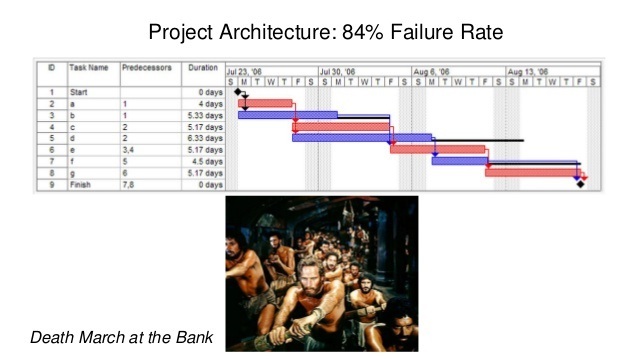
But the experience of combat piloting helped me understand the essence of the problem. These guys were not able to complete the project. We, fighter pilots, were told that it was necessary to very carefully land the plane right at the end of the runway. If this is not done and the plane lands in the middle of the strip, then it can get off it and go straight into the thickets of trees. The same thing happened with all these projects - they slipped off the strip and stuck in the trees.
I went to the executive director and said: “Your bank is absolutely not coping with the tasks. If you give the most unsuccessful project, I will definitely fix everything in it, just as I did in the case of company L2. ”
The director answered me: "God, if you need this headache, then please - you can proceed."
I said: “Great. I will bring a report every month to you and senior management on the condition that for the rest of the time no one should interfere in my work. We are going to create something like a small company in the company as a startup. ” Then we divided this company into small teams, sales, marketing, and engineering departments, where everyone worked together, motivated by a team spirit. We have established weekly cycles. We began to create a list of necessary tasks. And I taught them how to land a plane.
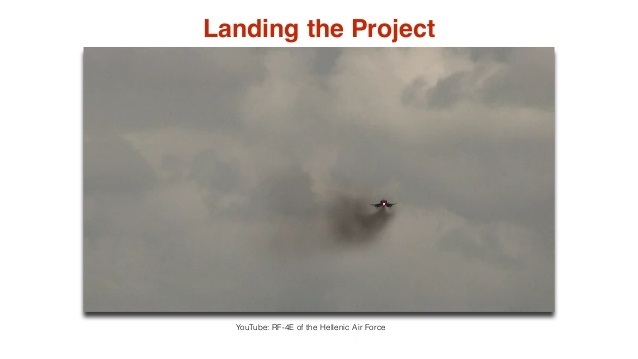
How can a pilot make an excellent landing? He must calculate the altitude, flight speed and decline, take into account the direction and strength of the wind and weather conditions, reconfigure every few seconds. Therefore, each week is a new attempt to land the plane at the end of the runway. Boom! Week after week they went to this, and, surprisingly, in six months they managed to get ahead of all the other teams. Their projects were considered the most disadvantageous, but soon became the most profitable. The reason for this is that everyone was responsible for their functions. They were given the task to correct the task, and they did it, managing to share responsibilities. The thing is that they were taught how to land a plane.
After this experience, I was invited to a number of other companies to resolve a number of some difficulties. I needed to figure out how to do this consistently and involve other people in the process. I could not be in one place all the time and give time to everyone. So, I had to think carefully about this. I ran a small French company in Cambridge, Massachusetts University of Technology. Five graduates of this university came to me and said: "We are opening a robot assembly company and would like to rent a room from you."
I replied: “Of course. We have a couple of extra rooms that you can use as laboratories. ”
They collected insect-like robots. And day after day, these robots crawled into my office, trying to track me down with the help of sensors that respond to heat. The co-founder of the company was a senior professor at the Massachusetts University of Technology, who sometimes went on Fridays to find out how things were going. Once I asked him a question: “Professor Brooks, how are these robots arranged?”
Here is what he replied: “Jeff, first of all, you need to realize that over the past thirty years, we, at our university, have struggled to create artificial intelligence. We suffered a complete failure. We tried to build a control system tied to powerful computers with huge databases. It did not help. All we have achieved is an intelligent chess program. Therefore, we began to observe insects, and the idea came to me to create something with a distributed intellect. For example, a chip located in the leg would control the leg. A chip in the spine would coordinate the movement of the legs. A neural network in the head would be responsible for the direction of movement.
He turned on the robot, whose legs cracked slightly, and the insect hobbled forward. It was like the first steps of a child, but after three minutes the robot freely ran around the room.
I was delighted: “Wow, that's great. I have some developers who would like to give speed. Perhaps we could teach them a few simple rules. And they will understand what it is like to join a team of super-intellectuals. How do you think it will work? ”
And he agreed: “Why don't you do this?”
I had to postpone this question for a while. The company - a very successful company - hired me to prepare a new product. They were going to replace all old goods with new ones in the shortest time.
And I had to figure out how to do it. Our product was intended for use by very large
companies, and I had to show them the best way to use it. We studied specialized literature and found a brilliant job in a Harvard business survey, written by Japanese professors Nonaka and Takeuchi, who described three different management styles. Number one is the Gantt chart. But you already know what its use leads to. Number two is Fuji Xerox's interim strategy. Number three is what they saw in the best factories in the world.
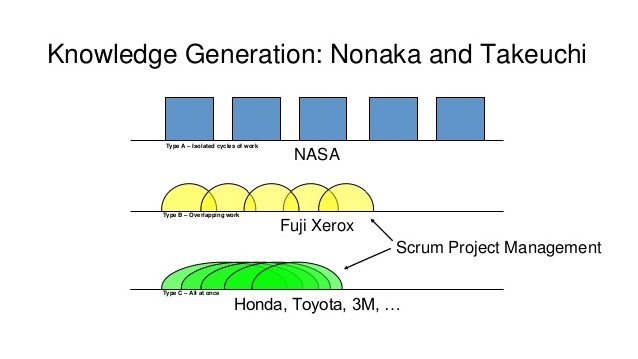
So, we stopped at number three, which Nonaka and Takeuchi report about as self-organized, independent teams. Management must make concessions, let them decide for themselves in which direction to move.
We implemented this method in 1993. By 1995, I had teamed up with Ken Schwaber. We began to focus on industry. In 2001, we wrote Agile Manifesto. And from that moment, it began to spread throughout the world, in all the major software companies that produce fighter planes, agricultural equipment, and spacecraft. In the picture you see a car company, the process of manufacturing a car in one week cycle. One car per week.
But the forward manifesto is now in schools in the USA and Europe. I recently attended a school in the Netherlands, where children were taught self-education. As soon as the bell rings, they rush into the classroom. They are divided into groups of four people, run to the wall, expose their scouts on it on it. Now they have a short afternoon meeting where they discuss what they did yesterday, what they will do today, and what problems they need to resolve. They run to the tables and get to work. Teachers just stand silently. They only talk when they are approached with requests for help.
Inexpressible enthusiasm is visible in children. I stand here with the rest of the teachers. Children say that they learn faster and get more good grades. They have fewer working days. They are so much more fun. Everything they do fits the definition of fun, and they are confident in their success. Children with disabilities are also involved in the learning process as team members. The problem of motivation disappears. There are no problems with discipline. Teamwork teaches self-discipline.
If they need some help from a teacher, they may ask, but usually they don’t. This is the future of education. And if you look at the world in which most of us live, then it is significantly different from this future. Studies show that many people do not like their job. The only thing that can be worse for them than work is to lie sick in bed.
Recently, I asked the developer and programmer of the Parisian company BMW Software what he thinks about the Scrum Team method. He choked, and then burst into tears: “I cannot convey to you the happiness that I experienced. It has changed my whole life. ”
Everyone can experience it. You can regain your strength, regain your freedom and start a new life. This incredible feeling will give you happiness, and you will remember this all your life. This is what I want for every person in this room. You need to stop holding on to the old and grab onto the new for this to happen.
Thanks for attention.
And this is how Edison explains what agile is:
The publication is supported by the Edison company , which is developing a notification system for traders , as well as creating a system of energy and water metering for a cottage village .

Hello!
Today I want to talk about life, freedom and the search for happiness - the Great American Dream, which often remains unfulfilled. As the poet Robert Burns said: “Even the most carefully constructed plans fail both in mice and humans,” which cannot but cause inconvenience and psychological discomfort, instead of the expected satisfaction.
I first encountered this problem as a cadet at the US Military Academy. During our training, we had to go through fire, water and copper pipes, and the year before graduation I was appointed an officer of the L2 company, which needed to solve the problem with drill training, as they had to participate in a military parade. The company was considered something like an outsider, because for a whole hundred years they could not do anything with the already established reputation of complete mediocrity and slackness. Decades went into futile attempts to teach them something and force them to train with great effort.
So I realized that I needed to do something completely new. And that’s what occurred to me: I won’t tell them what to do, but at night I will post color notes on the notice board in exactly the order in which their speech would look on the drill-ground, with precise indications of the shortcomings that they need to fix. For example, Charlie should stop, holding a weapon parallel to the floor, exactly in the middle of the march. The third platoon should be deployed synchronously, and its commander should pronounce commands distinctly, firmly and strictly at the indicated time.
To everyone's amazement, they became the best in the entire Cadet Corps in just three months. By that time, General MacArthur had died, who wished before his death that a group of cadets carry his coffin to the grave. The company L2 was chosen for this mission.
For those hopelessly lagging, escorting the deceased general to the grave is a big step forward. After graduating from the Academy, I joined the Air Force. Even at the Academy, I learned a lot from its leaders, I lived in a room with a fireplace, on which the inscription was carved: “Dwight D. Eisenhower lived here,” and, every time I read this inscription, I recalled his famous saying: “ Plans are nothing, planning is everything. ”

So when I became a combat pilot, I went into reconnaissance. We are constantly engaged in planning. But once one of my colleagues was shot down by a rocket over Vietnam. I knew that he really planned everything well. But he flew right over the target. And that was a deadly mistake.

From that day on, I began to include one prerequisite in my plan: to see my goal. And as soon as I was sent to North Vietnam, I mastered the evasion maneuver, because I knew that every second I was under fire. And only at the last moment, in one single second, I walked away from bullets, managing to take a photo.
And I stayed alive. Half of those with whom I flew did not return from their missions. When I again found myself in the USA, it was a complete surprise for me. I have been close to death so many times. Here I felt that I had found a new life. Every day was like a day of reward, a day of freedom. What was I to do with all this?
So I asked the Air Force to send me back to the aviation academy so I could teach there, or let me go back to school at Stanford. So I ended up at the Medical University of Colorado. I taught there for 11 years. There I worked in the field of building super-computer models of a human body cell, which would show how it develops, divides, and what provokes the formation of cancers, how to stop this process and how we can cure cancer.
And while I was there, a large banking company, under the control of which there are about 150 US banks, turned to us: “You are well aware that you have the most experience in developing the technologies that we use in our banks. You have knowledge, but no money. But we have money in banks. We offer you to work with us, which will mean a wonderful union of knowledge and money. ”
They made me an offer that my wife could not refuse - it was awesome for a poor university professor. And what did I see? I saw that they manage really large projects, involving hundreds of employees in them, and all these projects are implemented using the Gantt chart.
This is exactly the technology that was introduced into the US Army in 1910. During the First World War, it did not bring high results. And all because each part of the project is developed in a certain period of time. If any of the employees is not involved in the work on the project in this period, the deadlines for project completion are postponed. This, in turn, is reflected in the mood of the clients and the complacency of the managers, who then force their subordinates to work on nights and weekends. They work at a grueling pace, making incredible march-throws. It reminds me of Roman galleys, which are set in motion by slaves on oars, who row and row everything, and in the end the ship crashes.

But the experience of combat piloting helped me understand the essence of the problem. These guys were not able to complete the project. We, fighter pilots, were told that it was necessary to very carefully land the plane right at the end of the runway. If this is not done and the plane lands in the middle of the strip, then it can get off it and go straight into the thickets of trees. The same thing happened with all these projects - they slipped off the strip and stuck in the trees.
I went to the executive director and said: “Your bank is absolutely not coping with the tasks. If you give the most unsuccessful project, I will definitely fix everything in it, just as I did in the case of company L2. ”
The director answered me: "God, if you need this headache, then please - you can proceed."
I said: “Great. I will bring a report every month to you and senior management on the condition that for the rest of the time no one should interfere in my work. We are going to create something like a small company in the company as a startup. ” Then we divided this company into small teams, sales, marketing, and engineering departments, where everyone worked together, motivated by a team spirit. We have established weekly cycles. We began to create a list of necessary tasks. And I taught them how to land a plane.

How can a pilot make an excellent landing? He must calculate the altitude, flight speed and decline, take into account the direction and strength of the wind and weather conditions, reconfigure every few seconds. Therefore, each week is a new attempt to land the plane at the end of the runway. Boom! Week after week they went to this, and, surprisingly, in six months they managed to get ahead of all the other teams. Their projects were considered the most disadvantageous, but soon became the most profitable. The reason for this is that everyone was responsible for their functions. They were given the task to correct the task, and they did it, managing to share responsibilities. The thing is that they were taught how to land a plane.
After this experience, I was invited to a number of other companies to resolve a number of some difficulties. I needed to figure out how to do this consistently and involve other people in the process. I could not be in one place all the time and give time to everyone. So, I had to think carefully about this. I ran a small French company in Cambridge, Massachusetts University of Technology. Five graduates of this university came to me and said: "We are opening a robot assembly company and would like to rent a room from you."
I replied: “Of course. We have a couple of extra rooms that you can use as laboratories. ”
They collected insect-like robots. And day after day, these robots crawled into my office, trying to track me down with the help of sensors that respond to heat. The co-founder of the company was a senior professor at the Massachusetts University of Technology, who sometimes went on Fridays to find out how things were going. Once I asked him a question: “Professor Brooks, how are these robots arranged?”
Here is what he replied: “Jeff, first of all, you need to realize that over the past thirty years, we, at our university, have struggled to create artificial intelligence. We suffered a complete failure. We tried to build a control system tied to powerful computers with huge databases. It did not help. All we have achieved is an intelligent chess program. Therefore, we began to observe insects, and the idea came to me to create something with a distributed intellect. For example, a chip located in the leg would control the leg. A chip in the spine would coordinate the movement of the legs. A neural network in the head would be responsible for the direction of movement.
He turned on the robot, whose legs cracked slightly, and the insect hobbled forward. It was like the first steps of a child, but after three minutes the robot freely ran around the room.
I was delighted: “Wow, that's great. I have some developers who would like to give speed. Perhaps we could teach them a few simple rules. And they will understand what it is like to join a team of super-intellectuals. How do you think it will work? ”
And he agreed: “Why don't you do this?”
I had to postpone this question for a while. The company - a very successful company - hired me to prepare a new product. They were going to replace all old goods with new ones in the shortest time.
And I had to figure out how to do it. Our product was intended for use by very large
companies, and I had to show them the best way to use it. We studied specialized literature and found a brilliant job in a Harvard business survey, written by Japanese professors Nonaka and Takeuchi, who described three different management styles. Number one is the Gantt chart. But you already know what its use leads to. Number two is Fuji Xerox's interim strategy. Number three is what they saw in the best factories in the world.

So, we stopped at number three, which Nonaka and Takeuchi report about as self-organized, independent teams. Management must make concessions, let them decide for themselves in which direction to move.
We implemented this method in 1993. By 1995, I had teamed up with Ken Schwaber. We began to focus on industry. In 2001, we wrote Agile Manifesto. And from that moment, it began to spread throughout the world, in all the major software companies that produce fighter planes, agricultural equipment, and spacecraft. In the picture you see a car company, the process of manufacturing a car in one week cycle. One car per week.
But the forward manifesto is now in schools in the USA and Europe. I recently attended a school in the Netherlands, where children were taught self-education. As soon as the bell rings, they rush into the classroom. They are divided into groups of four people, run to the wall, expose their scouts on it on it. Now they have a short afternoon meeting where they discuss what they did yesterday, what they will do today, and what problems they need to resolve. They run to the tables and get to work. Teachers just stand silently. They only talk when they are approached with requests for help.
Inexpressible enthusiasm is visible in children. I stand here with the rest of the teachers. Children say that they learn faster and get more good grades. They have fewer working days. They are so much more fun. Everything they do fits the definition of fun, and they are confident in their success. Children with disabilities are also involved in the learning process as team members. The problem of motivation disappears. There are no problems with discipline. Teamwork teaches self-discipline.
If they need some help from a teacher, they may ask, but usually they don’t. This is the future of education. And if you look at the world in which most of us live, then it is significantly different from this future. Studies show that many people do not like their job. The only thing that can be worse for them than work is to lie sick in bed.
Recently, I asked the developer and programmer of the Parisian company BMW Software what he thinks about the Scrum Team method. He choked, and then burst into tears: “I cannot convey to you the happiness that I experienced. It has changed my whole life. ”
Everyone can experience it. You can regain your strength, regain your freedom and start a new life. This incredible feeling will give you happiness, and you will remember this all your life. This is what I want for every person in this room. You need to stop holding on to the old and grab onto the new for this to happen.
Thanks for attention.
Read more
- How Scrum was created: the story of Jeff Sutherland
- Sentimental meeting: how 17 anarchist developers in 2001 signed the Agile manifest
- Once again about seven core development methodologies
And this is how Edison explains what agile is:
The publication is supported by the Edison company , which is developing a notification system for traders , as well as creating a system of energy and water metering for a cottage village .
